
Key Takeaways
-
Thin-film solar panels offer a lightweight, flexible solution for farm irrigation, reducing reliance on non-renewable energy.
-
Despite a lower efficiency rate than traditional panels, thin-film excels in diverse weather conditions, making it suitable for varied farm environments.
-
Installation is straightforward and can be customized to fit different terrains and farm layouts.
-
Solar-powered irrigation systems can significantly lower water usage and energy costs, with potential for government incentives.
-
Adopting thin-film solar technology contributes to a sustainable agricultural future and a reduced carbon footprint.
Harvesting Sunshine with Precision: Power Your Farm
Imagine your farm not just as a place where crops grow, but as a powerhouse, harnessing the sun’s energy to fuel its own needs. Thin-film solar panels have become a game-changer in sustainable agriculture, providing farmers with an efficient and eco-friendly way to irrigate their lands. It’s not just about saving money – it’s about taking control of your resources and ensuring a resilient future for your farm.
The Role of Thin-Film Solar in Sustainable Farming
When it comes to farming, every drop of water counts. Thin-film solar panels can power irrigation systems, ensuring that your crops get the right amount of water without wasting a single drop. This technology is not only efficient but also aligns with sustainable practices, as it reduces the farm’s carbon footprint and dependency on non-renewable energy sources.
Cost and Efficiency Comparison: Thin-Film Versus Traditional Panels
Now, let’s talk numbers. Traditional solar panels, like monocrystalline and polycrystalline, have higher efficiency rates – they convert more sunlight into electricity. But thin-film panels are catching up. They’re typically less expensive and, because they’re lightweight and flexible, installation costs are often lower. In the long run, the savings on installation and materials can balance out the efficiency difference, especially for large-scale applications like farm irrigation.
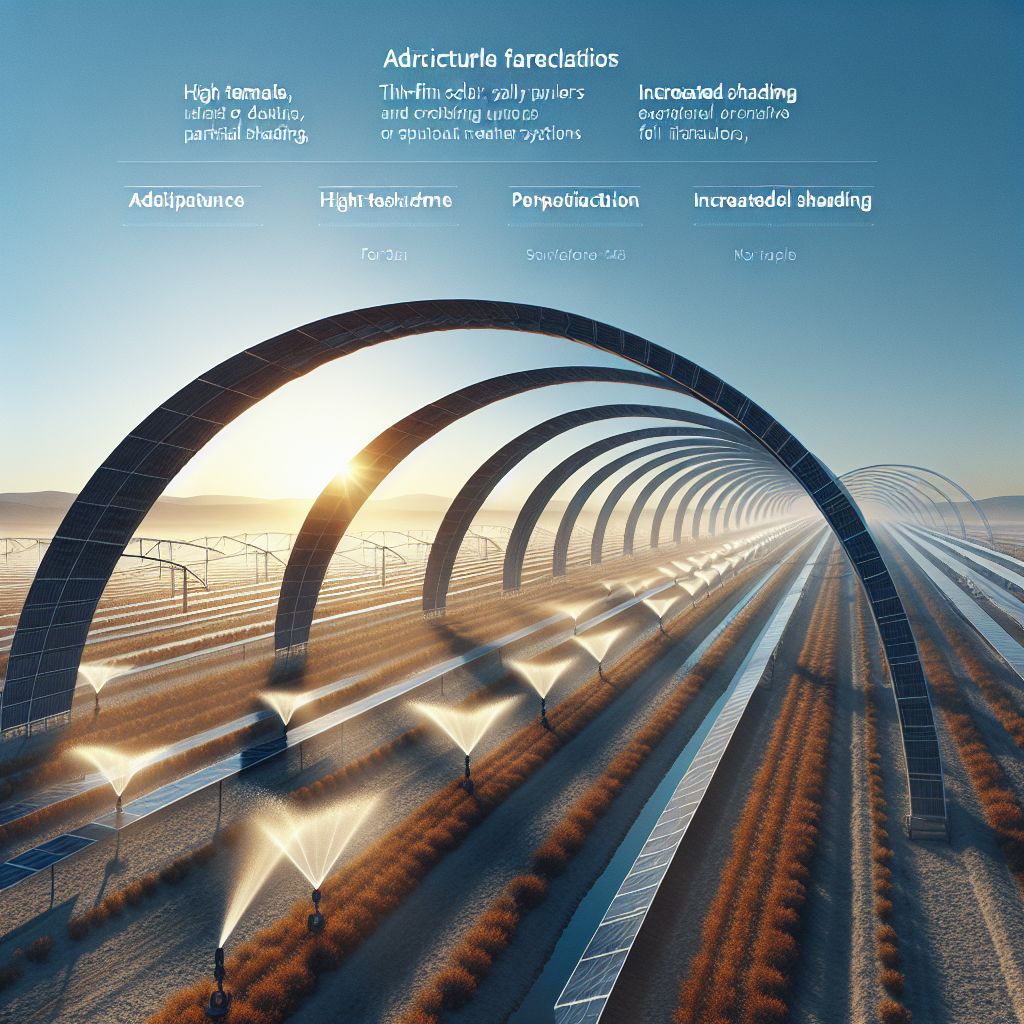
Advantages of Thin-Film Solar Panels for Irrigation
So, what makes thin-film solar panels stand out for irrigation? For starters, they’re champions at withstanding diverse weather conditions. High temperatures? No problem. Partial shading? They’ve got it covered. This resilience means you can rely on a consistent power supply to keep your irrigation systems running smoothly.
The table below show the advantages that can make thin-film solar panels a popular choice for powering irrigation systems:
| Advantage | Explanation |
|---|---|
| Lightweight and Flexible | Thin-film panels are lightweight and flexible, allowing for easy installation on various surfaces, including curved or uneven terrain commonly found in agricultural fields (1, 3). This flexibility facilitates integration with irrigation systems without the need for complex mounting structures. |
| Low-Light Performance | Thin-film panels perform better in diffused or low-light conditions compared to traditional crystalline silicon panels (3). This characteristic is beneficial for agricultural settings where partial shading from crops or trees may occur, ensuring consistent energy generation for irrigation systems. |
| Cost-Effective | The manufacturing process for thin-film panels is generally more cost-effective compared to traditional solar panels (1, 4). This lower cost makes them an attractive option for powering irrigation systems, particularly in regions with limited resources or budgets. |
| Durability | Thin-film panels are known for their durability and resistance to harsh environmental conditions, such as high temperatures and humidity, which are common in agricultural settings (1). This robustness ensures reliable operation and longevity for irrigation systems. |
| Off-Grid Compatibility | The lightweight and portable nature of thin-film panels makes them well-suited for off-grid applications, including remote agricultural areas without access to traditional power grids (3). This allows for sustainable and self-sufficient irrigation systems, reducing reliance on fossil fuels or grid infrastructure. |
| Scalability | Thin-film panels can be easily scaled up or down to meet the energy requirements of different irrigation systems, from small-scale farms to large agricultural operations (3). This flexibility in sizing and deployment facilitates efficient energy management for irrigation needs. |
Ease of Installation on Diverse Farm Terrains
Thin-film solar panels are increasingly popular for farm irrigation due to their flexibility and ease of installation on a variety of terrains. Unlike traditional solar panels, thin-film panels can be applied to uneven surfaces, making them ideal for the rolling hills and varied landscapes often found on farms. For more detailed insights, read about the components for solar-powered farm irrigation systems and how they can be adapted to different types of land.
Every farm is unique, with its own layout and challenges. Thin-film solar panels are versatile enough to meet these needs. You can install them on uneven ground, roll them out on large fields, or even integrate them into existing structures. The ease of installation means you can start reaping the benefits of solar power without a massive overhaul of your farm’s infrastructure.
Customizable Shapes and Flexibility
Thin-film panels are not rigid like traditional solar panels. They can bend and twist, which means they can take on shapes and configurations that fit the contours of your land. This flexibility allows you to maximize solar exposure and, consequently, energy production, no matter the shape or slope of your fields.
Minimal Structural Requirements for Mounting
Because thin-film panels are lighter, they don’t need heavy-duty mounting systems. This means less material, less labor, and less time before your solar irrigation system is up and running. And if you’re worried about durability, rest assured, these panels are tough enough to withstand the rigors of farm life.
Enhanced Efficiency in Diverse Weather Conditions
Thin-film panels have a unique advantage – they perform better in low-light conditions compared to their bulkier counterparts. This means that on cloudy days, or when the sun is playing hide and seek, your irrigation system won’t skip a beat. More consistent power equals more consistent growth for your crops.
Better Performance in High Temperatures
Heat can take a toll on traditional solar panels, causing their efficiency to dip just when you need them most. Thin-film panels, on the other hand, take the heat in stride. They maintain performance even as the mercury rises, providing a reliable energy source through the dog days of summer.
Reliability During Overcast or Shaded Conditions
Thin-film solar panels are known for their reliability during overcast or shaded conditions, making them suitable for areas with variable weather patterns and ensuring consistent operation of farm irrigation systems.
Even on those overcast days, thin-film solar panels continue to perform. Their ability to capture diffused sunlight means that even when conditions aren’t perfect, they’re still working hard to power your irrigation system. This reliability is crucial for maintaining a steady watering schedule for your crops.
Let’s not forget that thin-film solar panels can be a sight for sore eyes. They blend into the landscape more seamlessly than traditional panels, preserving the natural beauty of your farm. It’s a win-win: you get the power you need without compromising on aesthetics.
Now that you’ve got a grasp on the benefits of thin-film solar panels for farm irrigation, it’s time to roll up your sleeves and get into the nitty-gritty of setting up your own solar-powered irrigation system. In the next section, we’ll walk through the steps to integrate this innovative technology into your farming operations.
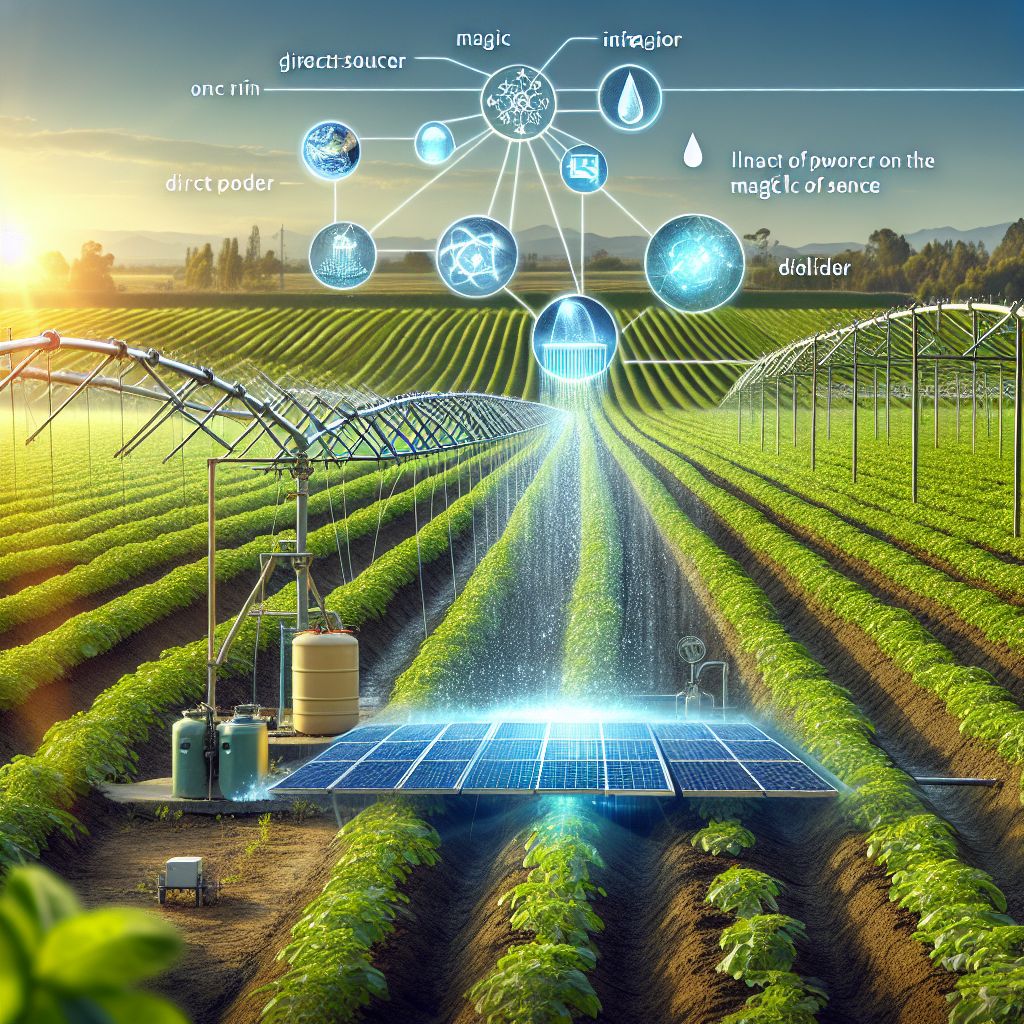
Converting Water Into Crops: The Solar Irrigation Setup
Transforming sunlight into a thriving crop is a bit like magic, but there’s science behind it. Solar irrigation systems are the wand in this scenario, and thin-film solar panels are the core spell component. These systems give you the ability to provide water to your crops efficiently, using energy harnessed directly from the sun.
Linking Thin-Film Panels to Irrigation Systems
Connecting thin-film solar panels to your irrigation system is like linking two powerful allies. The panels capture the sun’s energy, which is then used to pump water through your irrigation system. This direct source of power means that you can irrigate your fields without tapping into the grid or relying on diesel generators.
Step-by-Step Guide to Integrating Solar Power
Integrating solar power into your irrigation system is easier than you might think. First, assess your water needs and calculate the power required to meet them. Next, select the right size and number of thin-film solar panels. Then, install the panels, connect them to a solar pump controller, and hook up the pump. Finally, test the system to ensure it’s working correctly.
-
Assess water requirements for your crops.
-
Calculate the power needed for the pump.
-
Select and install the appropriate thin-film solar panels.
-
Connect panels to a solar pump controller.
-
Install and connect the pump to the irrigation system.
-
Test the system to ensure proper operation.
With these steps, you’ll have a solar irrigation system that’s both efficient and environmentally friendly. It’s a setup that not only saves water but also energy, cutting down on both your bills and your carbon footprint.
Most importantly, by using solar power, you’re ensuring that your farm’s water supply is not subject to the unpredictability of fuel prices or power outages. You’re creating a sustainable and reliable source of energy that keeps your crops growing even in the toughest times.
Optimizing Water Usage with Smart Irrigation Controllers
Once your thin-film solar panels are in place, it’s time to get smart about water usage. Smart irrigation controllers can take your farm’s efficiency to the next level. These devices monitor soil moisture, weather conditions, and plant water use to adjust watering schedules and amounts automatically.
By optimizing water usage, you’re not just saving resources; you’re ensuring that your plants get exactly what they need, exactly when they need it. This precision leads to healthier crops and, ultimately, higher yields.
Maintenance Tips for Prolonged Efficiency
To keep your solar irrigation system running at peak efficiency, regular maintenance is key. This means keeping an eye on your thin-film solar panels and ensuring they’re clean and free from obstructions that could block the sun’s rays.
Cleaning and Upkeep of Solar Panels
Keeping your solar panels clean is simple but crucial. Dust, leaves, and other debris can reduce their effectiveness, so regular cleaning is a must. A soft cloth or brush and some water are usually all you need to keep your panels in top shape.
Remember, a clean panel is a happy panel – and a more productive one, too. Just be gentle; you want to wipe away the grime without damaging the surface of the panels.
Regular System Monitoring and Troubleshooting
Along with cleaning, keep an eye on your system’s performance. If you notice a drop in efficiency, it could be a sign that something’s amiss. Quick troubleshooting can often resolve minor issues before they become major problems.
Regular monitoring not only keeps your system running smoothly but also helps you understand your farm’s energy patterns. This knowledge is power – the power to optimize, adjust, and ensure that your crops are getting the best care possible.
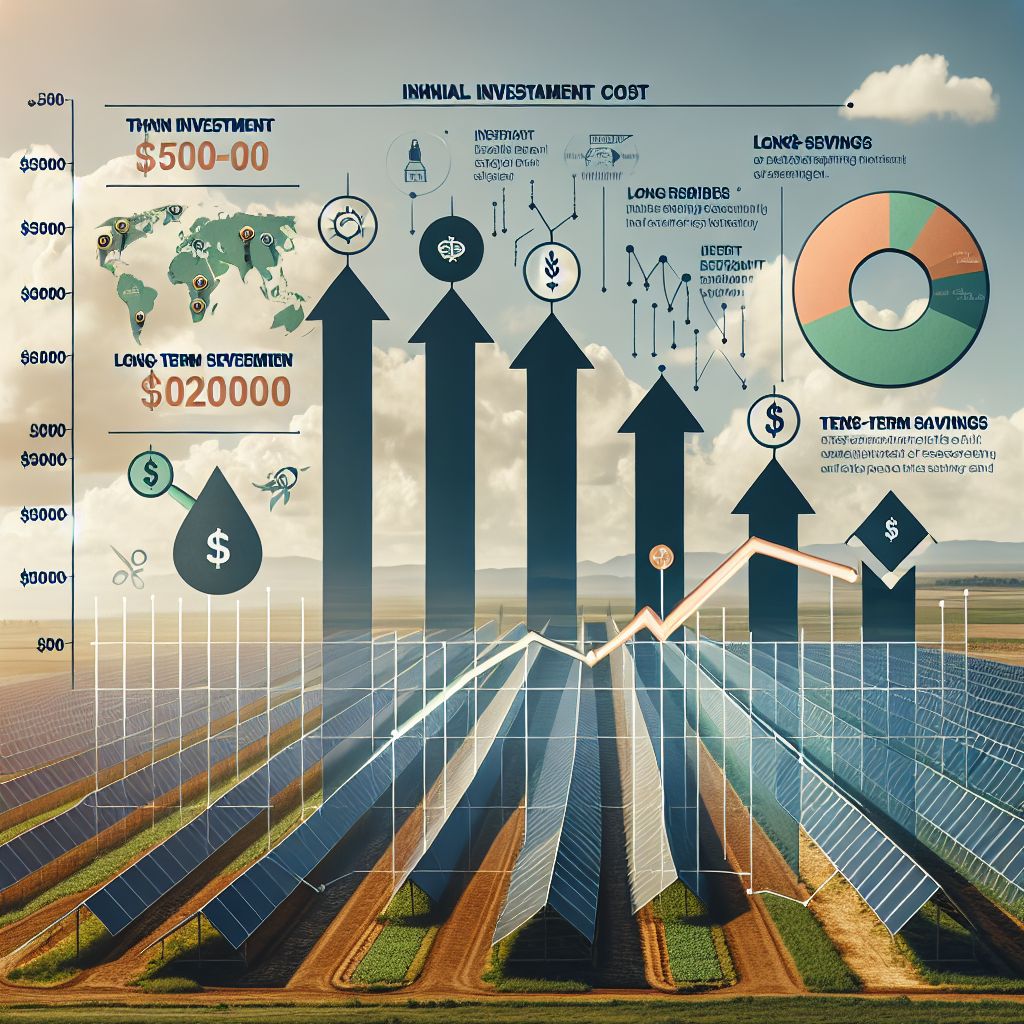
Economic Impact: The Cost-Benefit Analysis
Let’s talk economics. Investing in a solar irrigation system has upfront costs, but the long-term savings are substantial. Reduced water bills, lower energy costs, and less maintenance add up to significant financial benefits over time.
Understanding Upfront Investment and Long-Term Savings
The initial investment in thin-film solar panels and a solar-powered pump might seem steep, but consider this: you’re investing in your farm’s independence. Over time, the savings on energy and water can offset the initial cost. Plus, with the longevity of thin-film solar panels, you’re looking at years, if not decades, of savings.
Here’s a simple breakdown of potential costs and savings:
-
Initial investment in solar panels and pump: $5,000-$15,000, depending on size and complexity.
-
Annual savings on energy bills: $1,000-$3,000.
-
Reduced water usage and lower water bills: 20-50% savings.
-
Long-term savings: potentially tens of thousands of dollars over the system’s lifespan.
With these numbers in mind, it’s clear that the economic impact of a solar irrigation system is positive, making it a smart investment for forward-thinking farmers.
Government Incentives and Subsidies for Solar Agriculture
Besides the direct savings, there are often government incentives and subsidies available to help offset the cost of solar installations on farms. These can take the form of tax credits, rebates, or grants, and they’re designed to encourage the adoption of renewable energy sources.
By taking advantage of these programs, you can further reduce the financial barrier to going solar. It’s worth researching what’s available in your area, as these incentives can make a significant difference in the overall cost of your system.
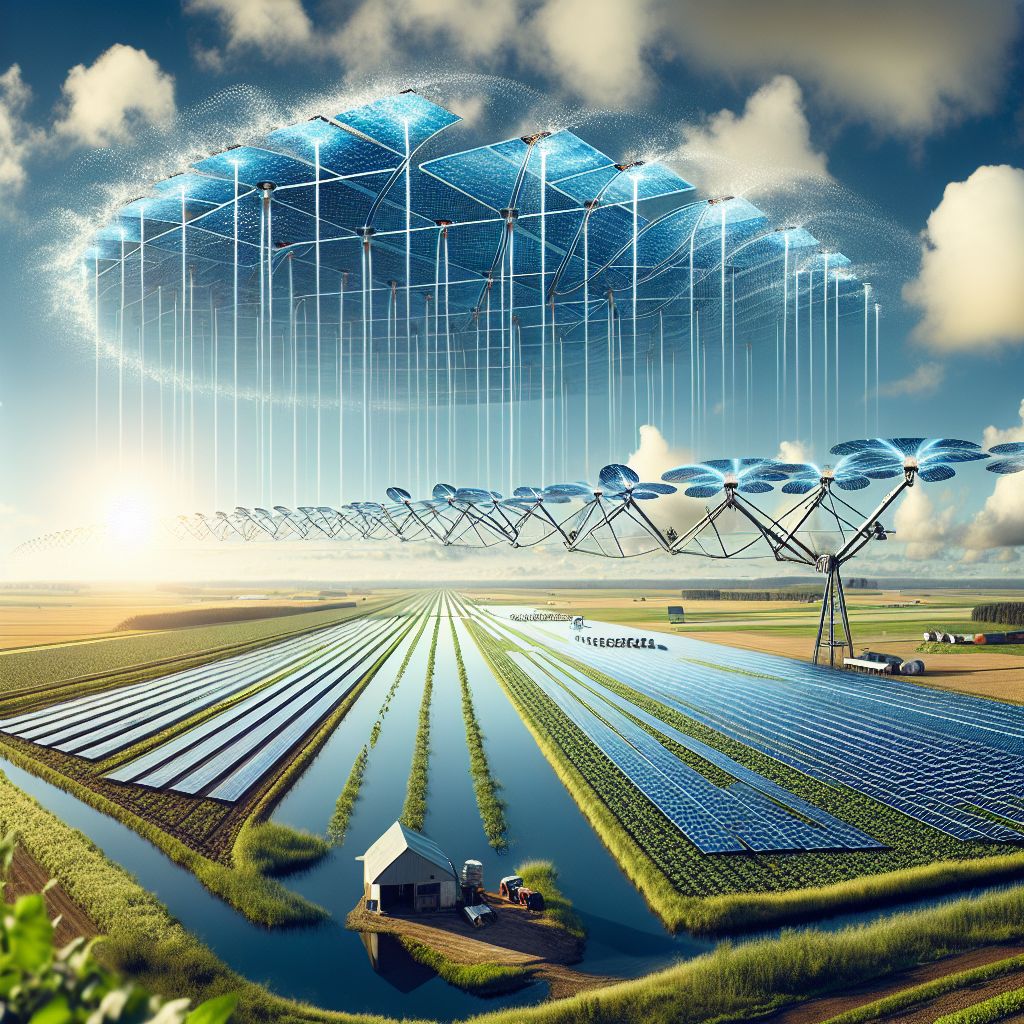
Environmental Benefits: Beyond the Farm
The benefits of thin-film solar panels for irrigation extend far beyond your farm’s boundaries. By choosing solar, you’re contributing to a larger movement towards sustainability and environmental responsibility.
Reducing Carbon Footprint through Solar Powered Irrigation
Every kilowatt-hour of energy produced by your thin-film solar panels is a kilowatt-hour not drawn from fossil fuels. This directly reduces your farm’s carbon footprint, helping combat climate change and preserving the planet for future generations.
It’s a simple equation: solar power equals cleaner energy, which equals a healthier environment. And as a farmer, you’re uniquely positioned to make a significant impact by adopting this technology.
Building a Sustainable Legacy for Future Farming Generations
Adopting thin-film solar technology is not just about the here and now; it’s about setting a precedent for sustainable farming practices that will endure for years to come. You’re laying the groundwork for a legacy of environmental stewardship that will inspire others and shape the future of agriculture.
By integrating solar power into your irrigation system, you’re demonstrating that it’s possible to grow crops efficiently and sustainably. This powerful message can ripple through the farming community, encouraging more and more farmers to follow suit.
Growing Success Stories: Farmers Embracing Thin-Film Solar
Around the world, farmers are already seeing the fruits of their labor with thin-film solar irrigation systems. Their success stories serve as powerful examples of what’s possible when innovation meets determination.
Spotlight on Innovative Farms Leading the Charge
Take, for example, a farm in California that switched to thin-film solar panels for its irrigation needs. Despite the initial costs, the farm is now saving thousands of dollars each year on energy bills, and the increased water efficiency has led to healthier crops and higher yields.
Another success story comes from a small farm in Kenya. With limited access to electricity, the farm turned to thin-film solar panels to power its irrigation system. Now, the farm thrives even during dry seasons, providing a stable income for the family and fresh produce for the community.
These stories are just the beginning. As more farmers adopt thin-film solar panels for irrigation, we’ll see a growing wave of sustainable agriculture that not only benefits individual farms but also the planet as a whole.
Embracing thin-film solar technology for farm irrigation systems is a step towards a more efficient and eco-friendly future. It’s a choice that pays off economically, environmentally, and ethically, empowering farmers to lead the way in sustainable agriculture.
As you consider the future of your farm, remember that innovation is the key to resilience and success. Thin-film solar panels for irrigation are more than just a technological advancement; they’re a commitment to a brighter, greener future for all.
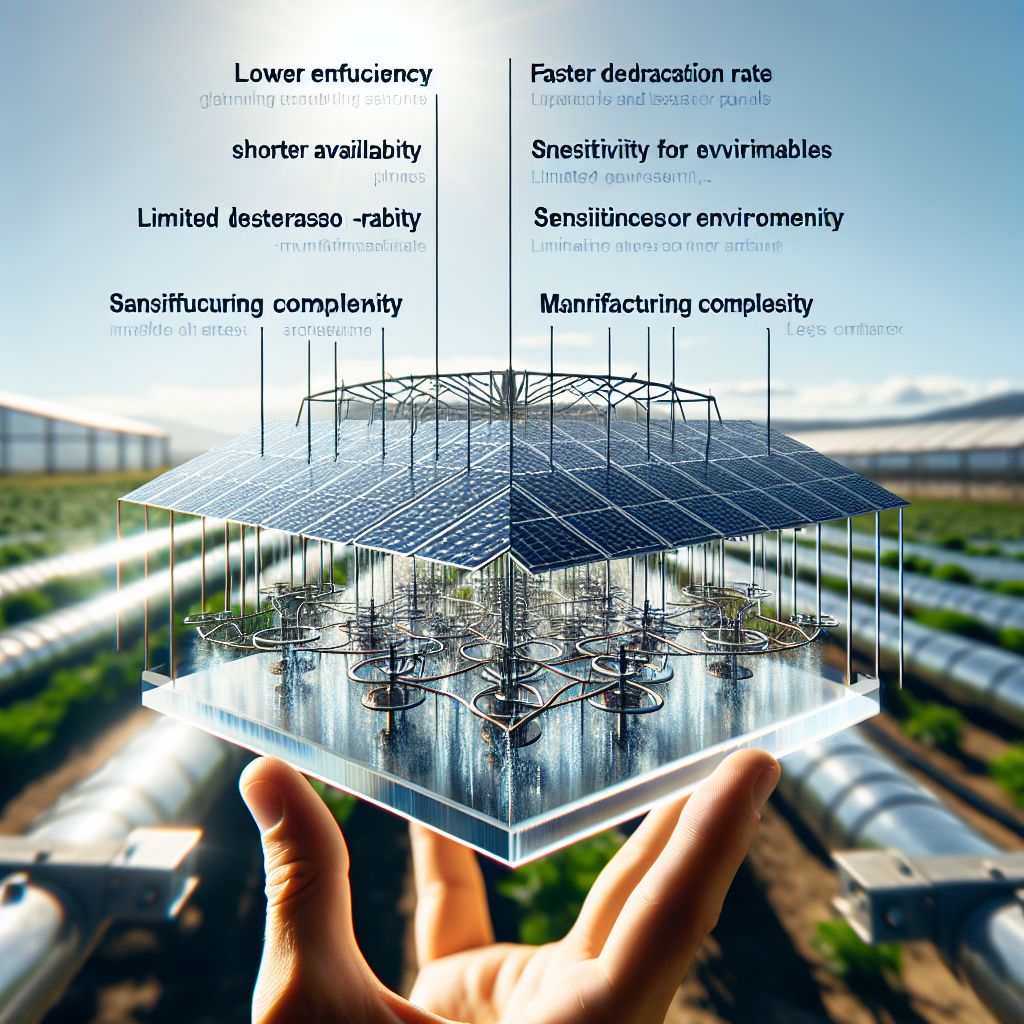
The Downside of Thin-Film Solar Panels for Irrigation
While the benefits of thin-film solar panels are numerous, it’s important to approach this technology with a balanced view. One downside is their lower efficiency compared to traditional solar panels. This means you might need more panels to generate the same amount of power, which requires more space. Additionally, thin-film panels typically have a shorter lifespan and may degrade faster, which could lead to increased costs over time.
This below table will show the disadvantages that should be considered when evaluating thin-film solar panels for irrigation systems, as they may impact overall performance, longevity, and cost-effectiveness of the solar irrigation system.
| Disadvantage | Explanation |
|---|---|
| Lower Efficiency | Thin-film panels generally have lower energy conversion efficiency compared to crystalline silicon panels (2, 3, 4). This means they require a larger installation area to generate the same amount of power, which may not be feasible for some agricultural settings. |
| Shorter Lifespan | Some thin-film technologies are more prone to degradation over time, resulting in a shorter lifespan of around 10-20 years, compared to crystalline panels (1, 4). This shorter lifespan could lead to more frequent replacements and higher long-term costs for irrigation systems. |
| Potential for Toxic Material Leakage | Certain thin-film panels, like those made with cadmium telluride (CdTe), use toxic materials in their manufacturing process (1). If the panels are damaged or cracked, there is a risk of these toxic materials leaching out, which could be problematic in agricultural settings where water collection may occur. |
| Fragility and Damage Concerns | Thin-film panels are generally more fragile and less durable than crystalline panels (1, 4). Walking or putting weight on them can lead to damage, affecting their energy performance and potentially causing electrical issues. This fragility may be a concern in agricultural environments where panels could be exposed to various hazards. |
The painful truth about using thin-film Solar Panels for Irrigation on a Farm
It’s not always sunshine and savings. The initial investment can be a hurdle for some farmers, and the technology might not be the best fit for every type of crop or farm. In areas with extreme weather, thin-film panels may be susceptible to damage, and their performance can still fluctuate with environmental conditions. Moreover, recycling options for thin-film panels are not as widespread as for traditional panels, raising concerns about their environmental impact at the end of their life cycle.
Final Insights
Despite these challenges, thin-film solar panels remain a compelling choice for many farmers. The key is to carefully consider your farm’s specific needs, the local climate, and the long-term financial implications. By doing so, you can make an informed decision that aligns with your goals for sustainability and efficiency.
“While thin-film solar panels are a significant step towards sustainable farming, it’s crucial to weigh the pros and cons specific to your farm’s conditions and long-term strategy.”
The Future of Farming: Is Thin-Film Solar the Key?
The future of farming is undoubtedly intertwined with advancements in renewable energy. Thin-film solar technology has the potential to play a pivotal role in this transformation, offering farmers an alternative way to power their irrigation systems and reduce their environmental footprint. As technology continues to evolve, we can expect to see even more efficient and durable options available for agricultural applications.
Frequently Asked Questions (FAQ)
How do thin-film solar panels work?
Thin-film solar panels work by using layers of semiconductor materials only a few micrometers thick to absorb sunlight and convert it into electricity. This technology allows the panels to be flexible and lightweight, making them suitable for a variety of surfaces and applications.
Can thin-film solar panels be used on any type of farm?
Yes, thin-film solar panels can be used on almost any type of farm. However, the suitability may vary depending on the farm’s location, available space, and specific energy needs. It’s essential to conduct a thorough assessment before making a decision.
What is the life expectancy of thin-film solar panels?
Thin-film solar panels typically have a life expectancy of around 15 to 25 years, which is shorter than the 25 to 30 years expected from traditional silicon-based solar panels. However, ongoing advancements in thin-film technology may increase their longevity in the future.
Are there financing options for farmers interested in solar irrigation?
Yes, there are various financing options available for farmers looking to invest in solar irrigation. These can include loans, leases, power purchase agreements (PPAs), and government incentives like grants and tax credits that can help offset the initial cost.
How do weather conditions affect thin-film solar panel performance?
Thin-film solar panels are known for their good performance in various weather conditions, including low light and high temperatures. However, like all solar technologies, their efficiency can be impacted by extreme weather, such as heavy snow or hail.
Conclusion: Are Thin-Filmed Solar Panels a Good Investment for a Farmer
Thin-film solar panels for irrigation systems are an investment in the future of farming. They offer a sustainable, cost-effective solution for water management, which is vital for crop growth and farm profitability. For farmers seeking to reduce their environmental impact and embrace renewable energy, thin-film solar panels are certainly worth considering. While thin-film solar panels may seem like an attractive option for irrigation systems due to their lightweight and flexible nature, they do have significant drawbacks that make them less suitable for this particular application. There are considerations to keep in mind, such as efficiency, lifespan, and upfront costs, the long-term benefits can be significant. It is essential to carefully consider these factors before investing in thin-film solar panels for irrigation system on your farm.






